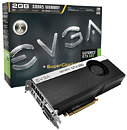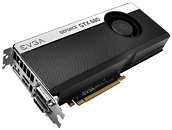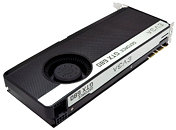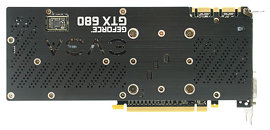Friday, April 13th 2012

EVGA Announces the GeForce GTX 680 SC Signature Graphics Cards
EVGA has today officially introduced a fresh pair Kepler cards, the GeForce GTX 680 SC Signature and GeForce GTX 680 SC Signature+ which feature a 5 phase PWM design, 8-pin and 6-pin PCIe power connectors (stock models come with two 6-pin plugs), and increased frequencies - 1084 MHz (1006 MHz stock) for the base clock, 1150 MHz for the boost clock (1058 MHz) and 6208 MHz (6008 MHz) for the 2 GB of on board GDDR5 memory.
These two tweaked GTX 680s also have 1536 CUDA Cores, a 256-bit memory interface, PCI-Express 3.0 support, SLI and 3D Vision Surround capabilities, and four display outputs - two DVI, one HDMI and one DisplayPort. The GeForce GTX 680 SC Signature has a price tag of $529.99 while the GeForce GTX 680 SC Signature+, which comes equipped with a backplate, costs $549.99. Neither model is available at this time.
These two tweaked GTX 680s also have 1536 CUDA Cores, a 256-bit memory interface, PCI-Express 3.0 support, SLI and 3D Vision Surround capabilities, and four display outputs - two DVI, one HDMI and one DisplayPort. The GeForce GTX 680 SC Signature has a price tag of $529.99 while the GeForce GTX 680 SC Signature+, which comes equipped with a backplate, costs $549.99. Neither model is available at this time.





43 Comments on EVGA Announces the GeForce GTX 680 SC Signature Graphics Cards
I like the looks, just not convinced (yet) by the advantage over reference cards, eventhough having more phases is always a good thing =)
-Article cleaned.
I'm still debeating on which one provinding the best cooling system for 24/7 GPGPU computing usage.
Damn good cooler. :)
Noise is not really a concern. I have a Fractal Design XL Case with plenty of silent fans and insonorised side pannels. I don't think I would notice the additional sound, it there is ...
My main concern is primary oriented through cooling efficiency.
If you wish to discuss this further, I'd suggest making your own thread, this is kinda getting off topic.
A mere 200Mhz boost (50Mhz true boost) on the memory clock is for want of a better word weak. My reference MSI 680 will do 6800Mhz all day long and I haven't even pushed it yet.
No doubt they have good reason not to on a mass released card but I would like it if they didn't just focus on core overclocking and completely forget the memory (especially as the 680 is somewhat lacking in the bandwidth stakes).
back then it was even higher. $800 bucks for an air cooled 8800 ultra
In reviewing this forum I noted several comparisons between the basically stock cooling system in the EVGA 680 SC Signature and some of the alternate cooling systems now being offered - I would just like to add that it may be important to consider how the alternate methods disperse the air from the card - the stock method pushes air out the back end and out of the case but many of the dual and triple fan systems just push air out anywhere they can - mainly back into the case - so while they may keep the card a little cooler or appear quieter it is important to consider whether or not you will then need additional case cooling to compensate - also if we are going to talk costs of old school video cards I personally had one of the earliest of the "higher end" dedicated gaming cards, the Diamond MONSTER - 4 or maybe 8 MB of ram, cost about $350 Canadian (about 20+ years ago - so maybe double that in today's dollars) and required a standard graphics card as well to actually interface to even just 1 monitor (another $100 - 150 or so for a decent standard video card) - so by comparison, I say that, while $500 - 600 is not inexpensive, it is still a considerable bargain by comparison to past leading edge consumer products of the same nature - P.S. - a 15 inch Sony Trinitron Tube Monitor was over $600 back then and 32 MB of system Ram was worth almost $600 as well due to a memory shortage - it seems there is always a key plant burning down or being flooded somewhere) - cheers